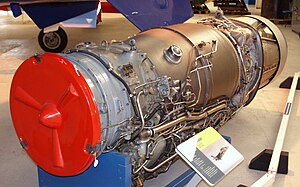Rolls-Royce Turbomeca Adour
| Adour | |
|---|---|

| |
| An Adour Mk 102 at the Royal Air Force Museum Cosford | |
| Type | Turbofan |
| Manufacturer | Rolls-Royce Turbomeca Limited |
| First run | Template:Avyear |
| Major applications | BAE Hawk McDonnell Douglas T-45 Goshawk Mitsubishi F-1 SEPECAT Jaguar |
| Number built | >2,800 |
The Rolls-Royce Turbomeca Adour is a two-shaft low bypass turbofan aircraft engine developed by Rolls-Royce Turbomeca Limited, a joint subsidiary of Rolls-Royce (UK) and Turbomeca (France). The engine is named after the Adour, a river in south western France.[1]
History
The Adour is a turbofan engine developed primarily to power the Anglo-French SEPECAT Jaguar fighter-bomber, achieving its first successful test run in 1968. It is produced in versions with or without reheat.
As of July 2009 more than 2,800 Adours have been produced, for over 20 different armed forces with total flying hours reaching 8 million in December 2009.[2] The U.S. military designation for this engine is the F405-RR-401 (a derivative of the Adour Mk 871), which is currently used to power the fleet of Boeing / BAE Systems T-45 Goshawk trainer jets of the United States Navy.
Variants
- Bench engines
- Ten prototype engines were built for testing by both Rolls-Royce and Turbomeca.[3]
- Flight development engines
- Development engines for the Jaguar prototypes, 25 built.[3]
Reheated (Afterburning)

- Adour Mk 101 - First production variant for the Jaguar, 40 built.[3]
- Adour Mk 102 - Second production variant with the addition of part-throttle reheat.[3]
- Adour Mk 104
- Adour Mk 106 - Replacement for the Jaguar's Mk104 engine (developed from the Adour 871) with a reheat section. The RAF refitted its fleet with this engine as part of the GR3 upgrade.[4] In May 2007, following the retirement of the last 16 Jaguars from No. 6 Squadron RAF, based at RAF Coningsby, the Adour 106 has been phased out of RAF service.[5]
- Adour Mk 801 - For Mitsubishi F-1 & T-2 (JASDF)
- TF40-IHI-801A - Licence-built version of Mk 801 by Ishikawajima-Harima for Mitsubishi F-1 & T-2 (JASDF)
- Adour Mk 804 - Licence-built by HAL for Indian Air Force phase 2 Jaguars
- Adour Mk 811 - Licence-built by HAL for Indian Air Force phase 3 to 6 Jaguars
- Adour Mk 821 - Engine upgrade of Mk804 and Mk811 engines, currently under development, for Indian Air Force Jaguar aircraft.
Dry (Non-afterburning)
- Adour Mk 151-01 Used by the Royal Air Force training aircraft fleet
- Adour Mk 151-02 - Used by the Red Arrows,
- Adour Mk 851
- Adour Mk 861
- Adour Mk 871 - Used by Hawk 200[6]
- F405-RR-401 - Similar configuration to Mk 871, for US Navy T-45 Goshawk.
- Adour Mk 951 - Designed for the latest versions of the BAE Hawk and powering the BAE Taranis and Dassault nEUROn UCAV technology demonstrators.[7] The Adour Mk 951 is a more fundamental redesign than the Adour Mk 106, with improved performance (rated at 6,500 lbf (29,000 N) thrust) and up to twice the service life of the 871.[8] It features an all-new fan and combustor, revised HP and LP turbines, and introduces Full Authority Digital Engine Control (FADEC).[citation needed] The Mk 951 was certified in 2005.
- F405-RR-402 - Upgrade of F405-RR-401, incorporating Mk 951 technology, certified 2008. Did not enter into service due to funding issues.
Higher bypass
- A higher-bypass version built around the core of the Adour and intended as a Spey replacement was developed by Rolls-Royce in 1967 as the Rolls-Royce RB.203 Trent
Applications
- Aermacchi MB-338 (not-built)
- BAE Hawk
- BAE Taranis (UCAV development aircraft)
- Dassault nEUROn (UCAV development aircraft)
- McDonnell Douglas T-45 Goshawk
- SEPECAT Jaguar
Licence-built
- Ishikawajima-Harima TF40-IHI-801A
Specifications (Adour Mk 106)
Data from Rolls-Royce[9]
General characteristics
- Type: Turbofan
- Length: 114 inches (2.90 m)
- Diameter: 22.3 inches (0.57 m)
- Dry weight: 1,784 lb (809 kg)
Components
- Compressor: 2-stage LP, 5-stage HP
- Turbine: 1-stage LP, 1-stage HP
Performance
- Maximum thrust: 6,000 lb (27.0 KN) dry / 8,430 lb (37.5 KN) with reheat
- Overall pressure ratio: 10.4
- Bypass ratio: 0.75-0.8
- Fuel consumption: dry 0.81 lb/(lbf⋅h) (23 g/(kN⋅s))
- Thrust-to-weight ratio: 4.725:1
See also
Related lists
References
- Notes
- ^ Gunston 1989, p.155.
- ^ Rolls-Royce PLC -Adour product page Retrieved: 21 July 2009
- ^ a b c d "Development of the Adour". Flight International: 649–650. 1973-04-26.
- ^ "Adour, power for the Hawk, Goshawk & Jaguar". Rolls-Royce plc, Dated: 1 April 2006.
- ^ "RAF Jaguar GR3/GR3A". Royal Air Force, Dated: May 2007.
- ^ "Hawk Trainer Aircraft". Air Force Technology. 2009. Retrieved 2014-08-07.
- ^ "BAE Systems Taranis". FlugRevue. 2007. Retrieved 2006-12-09.
- ^ "Rolls-Royce Adour Factsheet" (PDF).
- ^ Rolls-Royce Adour fact sheet Retrieved: 21 July 2009
- Bibliography
- Bill, Gunston (1989). World Encyclopedia of Aero Engines. Cambridge, United Kingdom: Patrick Stephens Limited. ISBN 978-1-85260-163-8.
